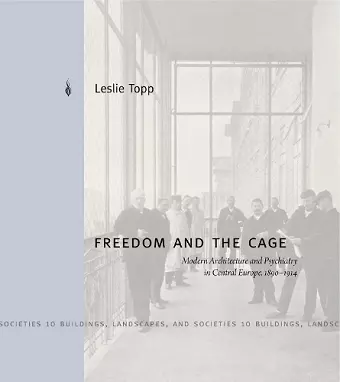Freedom and the Cage
Modern Architecture and Psychiatry in Central Europe, 1890–1914
Format:Hardback
Publisher:Pennsylvania State University Press
Published:28th Mar '17
Currently unavailable, and unfortunately no date known when it will be back

Spurred by ideals of individual liberty that took hold in the Western world in the late nineteenth century, psychiatrists and public officials sought to reinvent asylums as large-scale, totally designed institutions that offered a level of freedom and normality impossible in the outside world. This volume explores the “caged freedom” that this new psychiatric ethos represented by analyzing seven such buildings established in the Austro-Hungarian monarchy between the late 1890s and World War I.
In the last two decades of the Habsburg Empire, architects of asylums began to abandon traditional corridor-based plans in favor of looser formations of connected villas, echoing through design the urban- and freedom-oriented impulse of the progressive architecture of the time. Leslie Topp considers the paradoxical position of designs that promoted an illusion of freedom even as they exercised careful social and spatial control over patients. In addition to discussing the physical and social aspects of these institutions, Topp shows how the commissioned buildings were symptomatic of larger cultural changes and of the modern asylum’s straining against its ideological anchorage in a premodern past of “unenlightened” restraint on human liberty.
Working at the intersection of the history of architecture and the history of psychiatry, Freedom and the Cage broadens our understanding of the complexity and fluidity of modern architecture’s engagement with the state, with social and medical projects, and with mental health, psychiatry, and psychology.
“Topp shows how the interactions between architects and psychiatrists were materialized and expressed the formal and ideological developments of a contemporary architectural milieu that included Austrian architect Otto Wagner. Rounding out the book are careful analyses of the architectural forms and layouts of the complexes.”
—L. E. Carranza Choice
“Freedom and the Cage serves as an excellent model for research on institutions beyond hospitals, such as schools, prisons, convents, summer camps, day care centers, dormitories, long-term residential care facilities, and any other typologies that comprise multiple buildings and complex, mixed functions designed to keep people in. The book’s lessons come from broad and clear arguments about institutional design: that building design is often a critique of past buildings, propelling the evolution of the building type; that specialized buildings often work in conversation with each other, almost as if they were participating in an architectural debate; that architecture holds tremendous power in setting the ‘impression’ of how a place works, even from the curb or from the air; and, perhaps most important, that institutional architecture controls its users but not its historians.”
—Annmarie Adams Journal of the Society of Architectural Historians
“Scholars interested in the history of asylums in particular and historians of psychiatry more generally will draw inspiration from Freedom and the Cage. Throughout the book, Topp successfully uncovers the multilayered nature of psychiatric architecture, thereby raising questions about how hospital design played out in other societies, both European and non-European.”
—Sebastiaan Broere Isis: Journal of the History of Science Society
“An impressive and memorable text. . . . The book succeeds in bringing the asylum as a building type into full view, and reinforces the importance of social control as a critical lens for the analysis of modern architecture.”
—Kimberly Elman Zarecor Planning Perspectives
“Leslie Topp has written an important and impeccably researched corrective to widespread assumptions about the relationship between space and power in the design of asylums and in architecture more generally. Her investigation of the villa-type asylum and its relationship to regional identity in the final years of the Habsburg empire deserves to be read by all those interested in turn-of-the-century modern architecture.”
—Kathleen James-Chakraborty, author of Architecture since 1400
“The histories presented in Freedom and the Cage . . . are all the more timely as Central European societies consider the reform of mental health care and the role that institutional hospitals may continue to have into the 21st century.”
—Social History of Medicine
ISBN: 9780271077109
Dimensions: 254mm x 229mm x 24mm
Weight: 1315g
256 pages